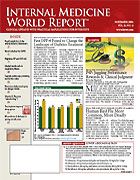Publication
Article
Medical Errors in the Elderly Linked to Increased Number of Treating Physicians
Author(s):
Lack of Coordinated Team Effort the Culprit
Older adults who see 5 physicians are 60% more likely to have an adverse drug event than those who see 2 physicians. This is one of the alarming statistics to emerge from a review of 12 months of prescription drugs claims from 2.4 million adults insured by Medco.
The analysis, which was conducted by Medco Health Solutions, also found that the risk for drug errors was 7 times greater in those aged ≥65 years compared with younger adults.
The number of prescriptions filled annually by seniors, as well as the number of potential drug errors, rose steadily in accordance with the increase in the number of prescribing physicians for the same elderly patient (Table).
“There is clearly a communication breakdown between prescribers,” noted Glen Stettin, MD, senior vice president, clinical and therapeutic solutions for Medco. “This analysis illustrates the potentially dangerous and unintended side effects of an expanded healthcare team—an issue that is exponentially more important now that Medicare has opened America’s medicine cabinet to many more older patients.”
In an effort to address some of these problems, Medco created a polypharmacy safety program to identify patients who are filling prescriptions written by multiple physicians or at multiple pharmacies. Patients enrolled in participating plans are automatically included in the program. In a 3-month period, the system identified >4600 patients with a polypharmacy risk and notified their physicians.
He added, “A wider array of physicians and specialists can improve care for the patient, but it is imperative that the team—physicians, pharmacists, and insurers—continually exchange information about what a senior is taking, how much of it is being prescribed, and for how long.”
Medicare Part D is expected to increase the use of prescription drugs among currently uninsured individuals by at least 20%, thus expanding the opportunities for adverse drug events even further.






